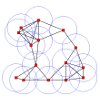Discrete Geometry and Combinatorics Seminar
I'll describe a derandomized variant of the percolation explorer process in an infinite wedge of hexagonal cells assigned states "plus" and "minus". Holroyd introduced this process a decade ago, inspired by the Cardy-Smirnov formula for percolation in a triangle. The derandomized process, extended to an infinite wedge, exhibits a form of self-organization in which at any given time the wedge is divided into distinct, slowly evolving "flow domains"; within each flow domain, successive particles flow along parallel exploration paths. We have made some progress toward analyzing the model by relating it to a derandomized version of the Polya urn model that replaces random propagation by rotor-routing. This is joint work with David Einstein and Alexander Holroyd.
